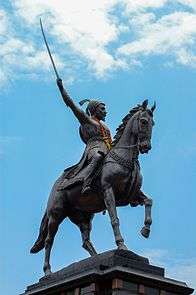Pratapgad
| Pratapgad | |
|---|---|
| प्रतापगड | |
| Satara District, Maharashtra, India | |
|
Pratapgad Fort. The upper fort is visible to the right of the photograph, while the outworks of the Afzal tower stretch away to the left. | |
|
View of one of the bastions ('buruj') of Pratapgad. | |
 Pratapgad | |
| Coordinates | 17°56′10″N 73°34′39″E / 17.936224°N 73.577607°ECoordinates: 17°56′10″N 73°34′39″E / 17.936224°N 73.577607°E |
| Type | Hill Fort |
| Site information | |
| Owner | Udayanraje Bhosale |
| Controlled by |
|
| Open to the public | Yes |
| Site history | |
| Built | 1656 |
| Built by | Shivaji |
| Battles/wars | Battle of Pratapgad |

Pratapgad (also transcribed Pratapgarh or Pratapgadh) literally 'Valour Fort' is a large fort located in Satara district, in the Western Indian state of Maharashtra. Significant as the site of the Battle of Pratapgad, the fort is now a popular tourist destination.
Geography
Pratapgad fort is located 15 kilometres (9.3 mi) from Poladpur and 23 kilometres (14 mi) west of Mahabaleshwar, a popular hill station in the area. The fort stands 1,080 metres (3,540 ft) above sea level[1] and is built on a spur which overlooks the road between the villages of Par and Kinesvar.
History
The Maratha king Shivaji Maharaj commissioned Moropant Trimbak Pingle, his prime minister, to undertake the construction of this fort in order to defend the banks of the Nira and the Koyna rivers, and to defend the Par pass. It was completed in 1656.[1] The Battle of Pratapgarh between Shivaji and Afzal Khan was fought below the rampants of this fort on November 10, 1659. This was the first major test of the fledgling kingdom's army, and set the stage of the establishment of the Maratha empire. Pratapgad continued to be involved in regional politics. Sakharam Bapu, a well-known minister of Pune, was confined by his rival Nana Phadnis in Pratapgad in 1778. He was later moved from fort to fort until he finally died at Raigad. In 1796, Nana Phadnis, while escaping from the intrigues of Daulatrao Shinde and his minister Baloba, assembled a strong garrison in Pratapgad before heading to Mahad. In 1818, as part of the Third Anglo-Maratha War, Pratapgad surrendered by private negotiation. This was a great loss to the Maratha forces, as Pratapgad was an important stronghold, had a large garrison, and could suppress much of the country around Wai. A 17 feet high equestrian bronze statue of Shivaji was unveiled by Jawaharlal Nehru, then Prime Minister of India, on the 30th of November 1957, the same year a road was constructed by the Public Works Department from Kumbhrosi village up to fort. A guest house and a national park were built inside the fort in 1960. The fort is currently owned by Uday Raje Bhosale, the heir to the former Satara princely state.
Structure
The fort can be divided into the lower fort and upper fort.
The upper fort was built upon the crest of the hill. It is roughly square, 180m long on each side. It has several permanent buildings, including a temple to the god Mahadev. It is located at the northwest of the fort, and is surrounded by sheer cliffs with drops of up to 250m.
The lower fort is around 320m long and 110m wide. It is located at the southeast of the fort, and is defended by towers and bastions ten to twelve metres high.
The Afzal tower extends out from the fort proper and defends the approach to the fort. It is said to have been constructed after the Battle of Pratapgad, and Afzal Khan's head is said to be buried under the tower.
In 1661, Shivaji Maharaj was unable to visit the temple of the goddess Bhavani at Tuljapur. He decided to dedicate a temple to the goddess at this fort itself. This temple is on the eastern side of the lower fort. The hall has been rebuilt since the original construction, and consists of wooden pillars about 50' long, 30' broad and 12' high. The shrine is made of stone, and contains a clothed black stone image of the goddess. The roof of the temple is flat inside, but covered in lead covering put up by the Satara Raja Pratapsinha (1818–1839). A small spire or shikhar covers the shrine.
A dargah of Afzal Khan is located a short while away from the fort to the south-east.
Tourism
Pratapgad is usually visited as a day-trip from the hill station of Mahabaleshwar, a popular tourist destination located 25 kilometres away.
It is also possible to take a ST bus from Panvel to Poladpur at night & then stay at Poladpur ST stand for the first ST to WADA (Base village). It is around 7am. When you reach at Wada village you can hire a 4-wheeler to the base of the Fort. But there is an alternate fantastic trekking road surrounded by greenery, for that you have to ask villagers first.(it's a bit hidden). But if you go by the main road then you can see an arrow on the road showing the exact path and then you can see old rock stairs. From this route you can go walking in around 30 minutes to the top of the fort. (total time 1.1/2hrs ). This was the old route of mawlas in ancient times. The main road was built by government when a bronze statue of Shivaji Maharaj was placed in the fort.
See also
| Wikimedia Commons has media related to Pratapgad. |
References
- 1 2 "Pratapgad Fort". Satara District Gazetteer. Government of Maharashtra, Gazetteers Department. Retrieved 2008-08-23.
.jpg)

